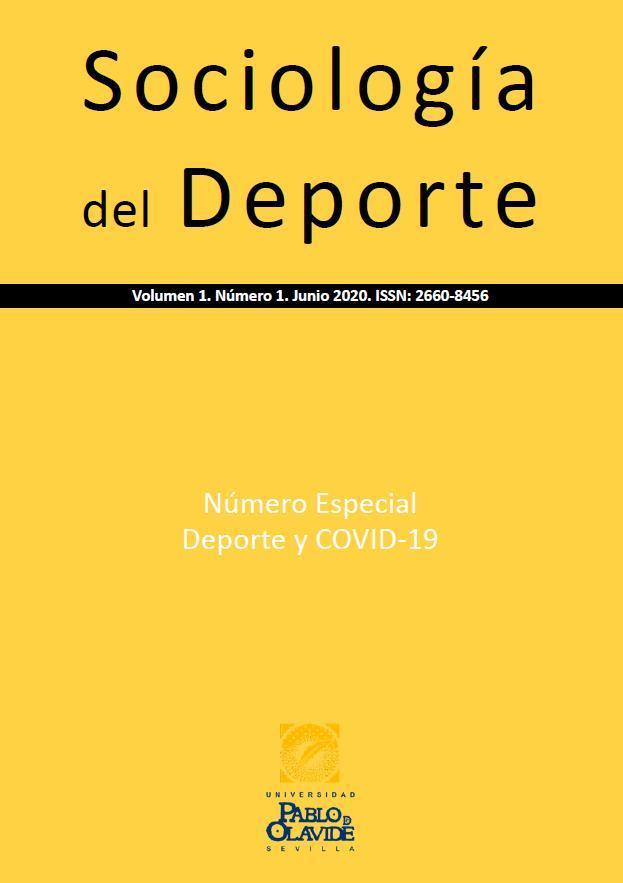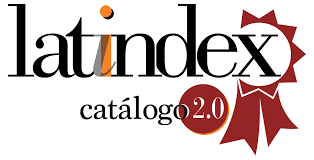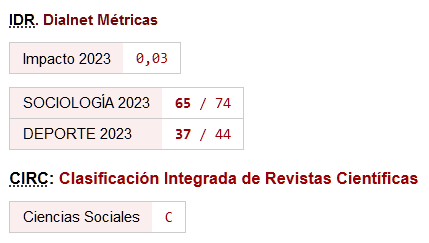Physical exercise in times of social isolation
A Bourdieusian reflection on tastes and distinction
DOI:
https://doi.org/10.46661/socioldeporte.4935Keywords:
COVID-19, Exercise, Inequality, Capital, HabitusAbstract
Since its recent outbreak and its rapid global spread, the COVID-19 pandemic has led to an unprecedented health and social crisis. Millions of people found their daily lives disrupted and have been confined for several weeks with the aim of reducing the contagion curve and preventing the collapse of health systems. Being aware of the risks to physical and mental health associated with a sedentary lifestyle, public authorities have attempted to promote an active lifestyle through physical exercise at home. Based on some of the sociological categories established by Pierre Bourdieu, this reflective article aims to discuss the realization (or not), by different sectors of the population, of physical exercise at home in the current context of confinement. Our position is that, in unequal social structures, typical of neoliberal states, the most disadvantaged sectors cannot even consider exercising. Strategies that focus on individual motivation not only cannot be effective, but also blame those who have no capital and no disposition to train in their homes.
Downloads
References
Amaral Junior, Alberto. 2020. “Desigualdade aumenta no mundo após pandemia de coronavírus: a crise gerada pela covid-19 só fez acentuar as diferenças econômicas entre os países.” Jornal da USP. 14 de abril. https://jornal.usp.br/radio-usp/desigualdade-aumenta-no-mundo-apos-pandemia-de-coronavirus
Badiou, Alain. 2020. “Sur la situation épidémique.” Quartier Général. 23 de marzo. https://qg.media/2020/03/26/sur-la-situation-epidemique-par-alain-badiou/
Bescansa, Carolina. 2020. “La distinción.” El País. 9 de mayo. https://elpais.com/opinion/2020-05-08/la-distincion.html
Bloomer, Martin, Phil Hodkinson y Stephen Billett. 2004. “The significance of ontogeny and habitus in constructing theories of learning.” Studies in Continuing Education 26 (1): 19-43.
Bourdieu, Pierre. 1977. Outline of a Theory of Practice. New York: Cambridge University Press.
Bourdieu, Pierre. 1978. “Sport and Social class.” Social Science Information 17 (6): 819-840.
Bourdieu, Pierre. 1989. O poder simbólico. Rio de Janeiro: Bertrand Brasil.
Bourdieu, Pierre. 1991. El sentido práctico. Buenos Aires: Taurus.
Bourdieu, Pierre. 1993. Sociology in Question. London: Sage.
Bourdieu, Pierre. 1998a. La distinción. Criterio y bases sociales del gusto. Buenos Aires: Taurus.
Bourdieu, Pierre. 1998b. Practical reasons: on the theory of action. Stanford: Stanford University Press.
Bourdieu, Pierre. 2003. “Gostos de Classe e Estilos de Vida.” En A sociologia de Pierre Bourdieu, editado por Renato Ortiz, 73-111. São Paulo: Olho D´agua.
Bourdieu, Pierre. 2008. A produção da crença: contribuição para uma economia dos bens simbólicos. Porto Alegre: Zouk.
Bourdieu, Pierre. 2011. “The forms of capital.” En Cultural theory: An anthology, editado por Imre Szeman y Timothy Kaposy, 81-93. Oxford: Wiley-Blackwell.
Bourdieu, Pierre. 2013. O senso prático. Petrópolis: Vozes.
Bourdieu, Pierre. 2014. “Notas provisórias sobre a percepção social do corpo.” Pro-Posições 25 (1): 247–256.
Bourdieu, Pierre y Jean-Claude Passeron. 2003. Los herederos. Los estudiantes y la cultura. Buenos Aires: Siglo XXI.
Bourdieu, Pierre y Roger Chartier. 2017. O sociólogo e o historiador. Belo Horizonte: Autêntica.
Brooks, Samantha K., Rebecca K. Webster, Louise E. Smith, Lisa Woodland, Simon Wessely, Neil Greenberg y Gideon James Rubin. 2020. “The psychological impact of quarantine and how to reduce it: rapid review of the evidence.” The Lancet 395 (10227): 912-920. doi:10.1016/S0140-6736(20)30460-8.
CMD Sport. 2020. “El confinamiento reduce un 40% la actividad física de los españoles.” 9 de abril. https://www.cmdsport.com/fitness/el-confinamiento-reduce-un-40-la-actividad-fisica-de-los-espanoles/
Facultad de Medicina de Ribeirão Preto. 2020. “Estimativa de casos de COVID-19.” Acceso 31 de mayo. https://ciis.fmrp.usp.br/covid19-subnotificacao/
Freire, Heike y José María Paricio. 2020. “Ocho falsas creencias sobre los niños y el confinamiento.” El País. 4 de abril. https://elpais.com/elpais/2020/04/03/mamas_papas/1585897899_412281.html
Gollás, Itzia Y. 2018. Las prácticas sociales que caracterizan la convivencia cotidiana de la escuela primaria pública. Guadalajara: ITESO.
Gonçalves, Aguinaldo. 2004. “Em busca do diálogo do controle social sobre o estilo de vida.” En Qualidade de Vida e políticas públicas: saúde, lazer e atividade física, editado por Roberto Vilarta, 17-26. Campinas: IPES.
Graeff, Billy, Diego Monteiro Gutierrez, Thais Sardá, Paul Bretherton y Marco Bettine. 2019. “Capable, splendorous and unequal: international media portrayals of Brazil during the 2014 World Cup.” Third World Quarterly 40 (4): 796-814. doi:10.1080/01436597.2018.1526070.
Hamer, Mark, Ngaire Coombs y Emmanuel Stamatakis. 2014. “Associations between objectively assessed and self-reported sedentary time with mental health in adults: an analysis of data from the Health Survey for England.” BMJ Open. doi:10.1136/bmjopen-2013-004580
Hargraves, Duane A. y Marika Tiggermann. 2004. “Idealized media images and adolescent body image: ‘comparing’ boys and girls.” Body Image 1 (4): 351-361. doi:10.1016/j.bodyim.2004.10.002.
Hodkinson, Phil y Andrew C. Sparkes (1997). “Careership: a sociological theory of career decision making.” British Journal of Sociology of Education 18 (1): 29-44.
Hodkinson, Phil, Gert Biesta y David James. 2008. “Understanding Learning Culturally: Overcoming the Dualism Between Social and Individual Views of Learning.” Vocations and Learning 1 (1): 27-47.
Márquez, Sara, Javier Rodríguez y Serafín De Abajo. 2006. “Sedentarismo y salud: efectos beneficiosos de la actividad física.” Apunts. Educacion Fisica y Deportes 83 (1): 12-24.
Ministério da Saúde. 2020a. “Casos e óbitos novos. Painel Coronavírus”. Acceso 30 de mayo. https://covid.saude.gov.br/
Ministério da Saúde. 2020b. “Como fica a prática de atividade física durante a pandemia de Coronavírus? Um roteiro de como incluir movimentos na sua rotina em tempos de Covid-19.” Acceso 30 de mayo. https://saudebrasil.saude.gov.br/eu-quero-me-exercitar-mais/como-fica-a-pratica-de-atividade-fisica-durante-a-pandemia-de-coronavirus
Ministerio de Cultura y Deporte. 2020. “La campaña #YoMeMuevoEnCasa del CSD y el Consejo COLEF recuerda la importancia de mantener un estilo de vida activo durante el estado de alarma.” Acceso 30 de mayo. http://www.culturaydeporte.gob.es/actualidad/2020/03/200318-covid19-csd-colef.html
Ministerio de Educación, Cultura y Deporte. 2015. “Encuesta de hábitos deportivos en España 2015.” Acceso 30 de mayo. https://www.culturaydeporte.gob.es/dam/jcr:aa63cca9-31a5-47ce-8ac2-105215f64d9f/Encuesta_de_Habitos_Deportivos_2015_Sintesis_de_Resultados.pdf
Ministerio de Sanidad. 2020. “Enfermedad por nuevo coronavirus, COVID-19. Información oficial del Ministerio de Sanidad dirigida a los profesionales sanitarios y a ciudadanía en relación a recomendaciones sanitarias y de salud pública de interés general.” Acceso 30 de mayo. https://www.mscbs.gob.es/profesionales/saludPublica/ccayes/alertasActual/nCov-China/home.htm
Ministério do Esporte. 2015. “Diesporte: diagnóstico nacional do esporte.” Acceso 30 de mayo. http://arquivo.esporte.gov.br/diesporte/
Narici, Marco et al. 2020. “Impact of sedentarism due to the COVID-19 home confinement on neuromuscular, cardiovascular and metabolic health: Physiological and pathophysiological implications and recommendations for physical and nutritional countermeasures.” European Journal of Sport Science. doi:10.1080/17461391.2020.1761076
Odgen, Jane. 2005. Psicología de la alimentación. Madrid: Morata.
Oxfam Intermón. 2019. “Desigualdad 1 – Igualdad de oportunidades 0. La inmovilidad social y la condena de la pobreza.” Acceso 30 de mayo. https://web.oxfamintermon.org/sites/default/files/documentos/files/desigualdad-1-igualdad-oportunidades-0.pdf
Petrie, Trent A. y Christy Greenleaf. 2012. “Eating Disorders in Sport: From Theory to Research to Intervention.” En Handbook of Sport Psychology, editado por Gershon Tenenbaum y Robert Eklund, 635-659. New York: Oxford University Press.
Poirel, Emmanuel. 2017. Bienfaits psychologiques de l’activité physique pour la santé mentale optimale. Santé Mentale au Québec 42 (1): 147-164. doi:10.7202/1040248ar.
Portalatín, Beatriz G. 2020. “Las enfermedades que tienes que vigilar durante el encierro, y no incluyen al coronavirus.” El Español. 20 de marzo. https://www.elespanol.com/mujer/saludables/20200320/enfermedades-vigilar-encierro-no-incluyen-coronavirus/475954149_0.html
Presidencia de Gobierno. 2020. “El Gobierno aprueba el Ingreso Mínimo Vital.” Acceso 30 de mayo. https://www.lamoncloa.gob.es/consejodeministros/resumenes/Paginas/2020/290520-cministros.aspx
Rosa, Hartmut. 2016. Alienación y aceleración: Hacia una teoría crítica de la temporalidad en la modernidad tardía. Buenos Aires: Katz.
Rubin, G. James y Simon Wessely. (2020). “Coronavirus: The psychological effects of quarantining a city.” The British Medical Journal. 24 de enero. https://blogs.bmj.com/bmj/2020/01/24/coronavirus-the-psychological-effects-of-quarantining-a-city/
Suchert, Vivien, Reiner Hanewinkel y Barbara Isensee. 2015. “Sedentary behavior and indicators of mental health in school-aged children and adolescents: A systematic review.” Preventive Medicine 76: 48-57. doi:10.1016/j.ypmed.2015.03.026
Teixidor, Clara. 2019. Factors de pressió pel pes a l’esport i la simptomatologia de trastorns de la conducta alimentària en esportistes d’elit de Catalunya (Tesis doctoral). Universitat de Barcelona.
Tiggermann, Marika. 2011. “Sociocultural perspectives on human appearance and body image.” En Body Image. A Handbook of Science, Practice and Prevention, editado por Thomas F. Cash y Linda Smolak, 12-19. New York: The Guilford Press.
Toro, Josep. 2015. El cuerpo como delito. Anorexia, bulimia, cultura y sociedad. Barcelona: Ariel.
Trapé, Átila A., Renato F. R. Marques, Elisângela A.S. Lizzi, Fernando E. Yoshimura, Laercio J. Franco y Anderson S. Zago. 2017. “Associação entre condições demográficas e socioeconômicas com a prática de exercícios e aptidão física em participantes de projetos comunitários com idade acima de 50 anos em Ribeirão Preto, São Paulo.” Revista Brasileira de Epidemiologia 20 (2): 355-367. doi:10.1590/1980-5497201700020015.
Ventura, Gemma. 2020. “Heike Freire: «Els infants haurien de sortir una hora al dia»” Catorze. 12 de abril. https://www.catorze.cat/noticia/14050/heike/freire/infants/haurien/sortir/hora/al/dia
Viejo, Manuel. 2020. “La explicación psicológica a la lista estrella de la compra en cuarentena: cerveza, aceitunas y patatas.” El País. 2 de abril. https://elpais.com/espana/madrid/2020-04-01/la-explicacion-psicologica-a-la-lista-estrella-de-la-compra-en-cuarentena-cerveza-anchoas-aceitunas-y-patatas-fritas.html
Yan, Zhen y Hannah R. Spaulding. 2020. “Extracellular Superoxide Dismutase, a Molecular Transducer of Health Benefits of Exercise.” Redox Biology 32. doi:10.1016/j.redox.2020.101508

Published
How to Cite
Issue
Section
License
Copyright (c) 2020 Pau Mateu, Renato Francisco Rodrigues Marques

This work is licensed under a Creative Commons Attribution-NonCommercial-ShareAlike 4.0 International License.








